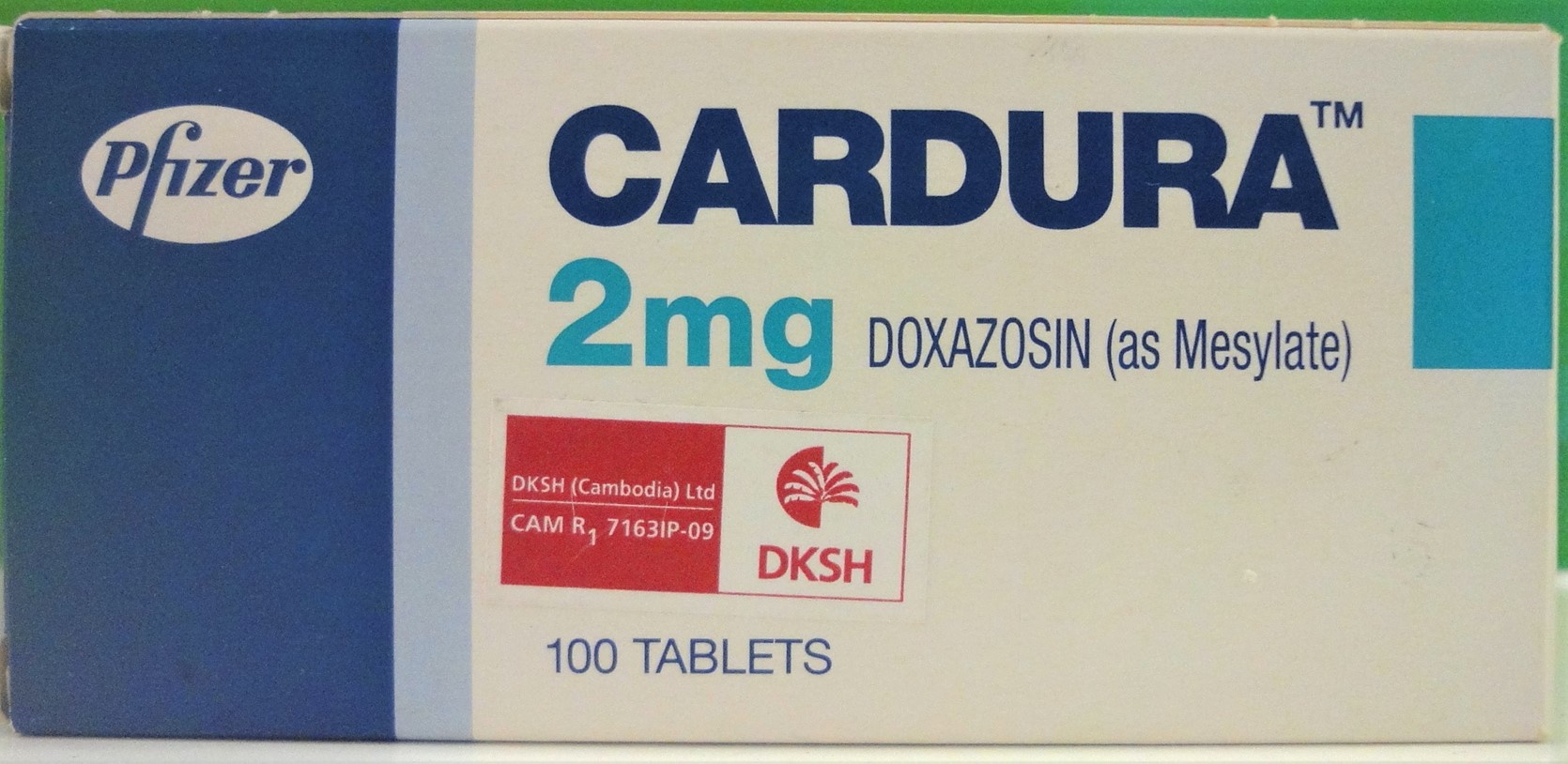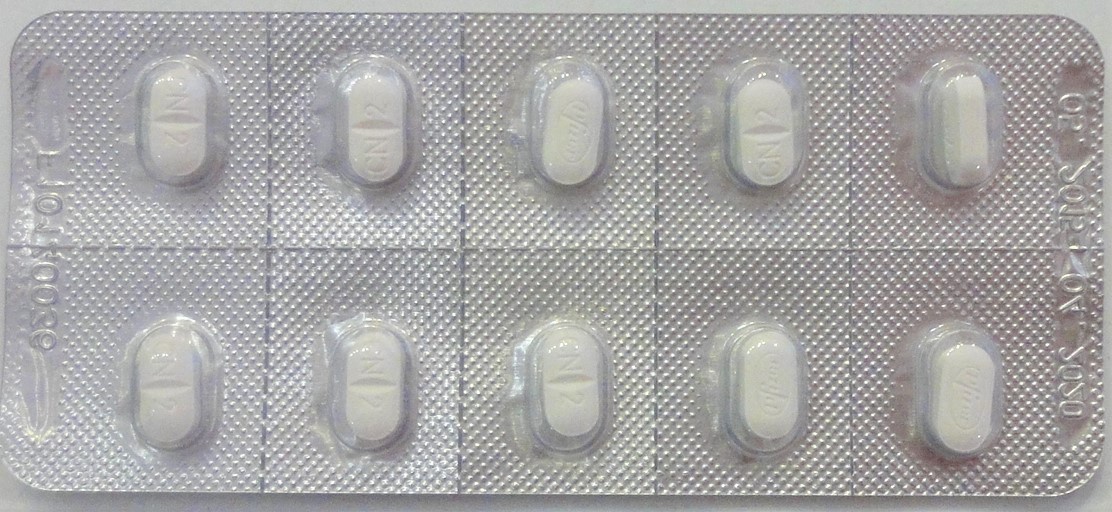CARDURA Tablet
ក្រុមហ៊ុនផលិតឱសថ:
PfIzer
ក្រុមហ៊ុនចែកចាយឱសថនៅប្រទេសកម្ពុជា:
DKSH


- សារធាតុសកម្ម
- ប្រសិទ្ធិភាពព្យាបាល និង កម្រិតប្រើប្រាស់
- ហាមប្រើ
- ផលរំខាន
- អន្តរប្រតិកម្ម
- ស្ត្រីមានផ្ទៃពោះ និង ស្ត្រីបំបៅដោះកូន
- ការប្រុងប្រយ័ត្នជាពិសេស បរិយាយប័ណ្ណឱសថ
-
សារធាតុសកម្ម
Doxazosin 2mg
-
ប្រសិទ្ធិភាពព្យាបាល និង កម្រិតប្រើប្រាស់
Doxazosin may be administered either in the moming or in the evening.
-Hypertension:
The full dosage range of doxazosin is 1mg to16mg daily. lt is recommended that therapy be initiated at 1mg once daily for 1 or 2 weeks to minimize the potential for postural hypotension and/or syncope. The dosage may then be increased to 2mg once daily for additional 1 or 2 weeks. If necessary, the daily dosage should then be increased gradually at similar intervals to 4 mg, 8 mg, and 16 mg, as determined by patient response, to achieve the desired reduction in blood pressure. The usual dose is 2 mg to 4 mg once daily.
-Benign Prostatic Hyperplasia:
The recommended initial dosage of doxazosin is 1 mg once daily to minimize the potential for postural hypotension and/or syncope. Depending on the individual patient's urodynamics and BPH symptomatology, dosage may then be increased to 2mg and there after to 4mg and up to the maximum recommended dose of 8mg. The recommended titration interval is 1 to 2 weeks. The usual recomrnended dose is 2 to 4 mg once daily.
-Use in Elderly:
Normal adult dosage is recommended.
-Use in Renally Impaired Patients:
Since the pharmacokinetics of doxazosin are unchanged in patients with renal insufficiency, and there is no evidence that doxazosin aggravates existing renal dysfunction, the usual dosages may be used in these patients.
-Use in Hepatically Impaired Patients:
As with any drug wholly metabolized by the liver, doxazosin should be administered with caution to patients with evidence of impaired hepatic function.
-Use in Children:
The safety and efficacy of doxazosin in children have not been established.
-
ហាមប្រើ
Doxazosin is contraindicated in patients with a known hypersensitivity to quinazolines, doxazosin, or any of the inert ingredients.
-
ផលរំខាន
Hypertension
In controlled clinical trials, the most common reactions associated with doxazosin were of a postural type (rarely associated with syncope) or non-specific and included:
-Ear and Labyrinth Disorders: vertigo
-GastrointestinaI Disorders : nausea
-General Disorders and Administration Site Conditions: asthenia,edema, fatigue, malaise
-Nervous System Disorders: dizziness, headache,postural dizziness, somnolence, syncope
-Respiratory,Thoracic and Mediastinal Disorders: rhinitis
Benign Prostatic Hyperplasia
Experience in controlled clinical trials in BPH indicates a similar adverse event profile to that seen in hypertension.
In post-marketing experience, the following additional adverse events have been reported:
-Blood and Lymphatic Disorders: leukopenia, thrombocytopenia
-Ear and Labyrinth Disorders: tinnitus Eye Disorders: blurred vision, IFIS (lntraoperative Floppy lris Syndrome)
-GastrointestinaI Disorders: abdominal pain,constipation,diarrhea,dyspepsia, flatulence,mouth dry,vomiting
-General Disorders and Administrations Site Conditions: pain
-Hepatobiliary Disorders: cholestasis, hepatitis, jaundice
-lmmune System Disorders: allergic reaction
-lnvestigations: abnormal liver function tests, weight increase
-Metabolism and Nutrition: anorexia
-Musculoskeletal and Connective Tissue Disorders : arthralgia, back pain, muscle cramps, muscle weakness, myalgia
-Nervous System Disorders : hypoesthesia, paresthesia, tremor
-Psychiatric Disorders: agitation, anxiety depression, insomnia, nervousness
-Renal and urinary Disorders: dysuria, hematuria, micturition disorder, micturition frequency, nocturia, polyuria, urinary incontinence
-Reproductive System and Breast Disorder: gynecomastia, impotence, priapism, retrograde ejaculation
-Respiratory, Thoracic and Mediastinal Disorders: bronchospasm aggravated, coughing, dyspnea, epistaxis
-Skin and Subcutaneous Tissue Disorders: alopecia, pruritus, purpura, skin rash, urticaria
-Vascular Disorders: hot flushes, hypotension, hypotension postural
The following additional adverse events have been reported in marketing experience among patients treated for hypertension but these, in general, are not distinguishable from symptoms that might have occurred in the absence of exposure to doxazosin: bradycardia, tachycardia, palpitation, chest pain, angina pectoris, myocardial infarction, cerebrovascular accidents, and cardiac arrhythmias.
-
អន្តរប្រតិកម្ម
1.Used with PED-5 Inhibitors
Concomitant administration of doxazosin with a Phosphodiesterase Type-5 (PED-5) inhibitor should be used with caution as it may lead to symptomatic hypotension in some patients.
2.Other:
Most (98%) of the plasma doxazosin is protein bound. In vitro data in human plasma indicate that doxazosin has no effect on protein binding of digoxin, warfarin, phenytoin or indomethacin. Doxazosin has been administered without any adverse drug interaction in clinical experience with thiazide diuretics,furosemide, beta-blockers, non-steroidal anti-inflammatory drugs, antibiotics, oral hypoglycemic drugs, uricosuric agents, or anticoagulants.
In an open-label, randomized, placebo-controlled trial in 22 healthy male volunteers, the administration of a single 1 mg dose of doxazosin on Day 1 of a 4-day regimen of oral cimetidine (400 mg twice daily) resulted in a 10% increase in mean AUC of doxazosin, and no statistically significant changes in mean Cmxa and mean half-life of doxazosin. The 10% increase in the mean AUC for doxazosin with cimetidine is within intersubject variation(27%) of the mean AUC for doxazosin with placebo.
-
ស្ត្រីមានផ្ទៃពោះ និង ស្ត្រីបំបៅដោះកូន
Although no teratogenic effects were seen in animal testing with.doxazosin, reduced fetal survival was observed in animals at extremely high doses.These doses were approximately 300 times the maximum human recommended dose. Animal studies have shown that doxazosin accumulates in breast milk.
As there are no adequate and well-controlled studies in pregnant or nursing women, the safety of doxazosin during pregnancy or lactation has not yet been established. Accordingly, during pregnancy or lactation, doxazosin should be used only when, in the opinion of the physician, the potential benefit outweighs the potential risk.
-
ការប្រុងប្រយ័ត្នជាពិសេស
Postural Hypotension/Syncope
A very small percentage of patients have experienced postural hypotension evidenced by dizziness and weakness, or rarely loss of consciousness (syncope), particularly with the commencement of therapy. When instituting therapy with any effective alpha-blocker, the patient should be advised how to avoid symptoms resulting from postural hypotension and what measures to take should they develop. The patient should be cautioned to avoid situations where injury could result should dizziness or weakness occur during the initiation of doxazosin therapy.
Use with Phosphodiesterase Type-5 Inhibitors
Concomitant administration of doxazosin with a Phosphodiesterase Type-5 (PDE-5) inhibitor should be used with caution as it may lead to symptomatic hypotension in some patients.
Impaired Hepatic Function
Doxazosin should be administered with caution to patients with evidence of impaired hepatic function.
Intraoperative Floppy Iris Syndrome
The intraoperative floppy iris syndrome (IFIS), a variant of small pupil syndrome, has been observed during cataract surgery in some patients on or previously treated with alpha-1 blockers. As IFIS may lead to increased procedural complications during the operation, current or past use of alpha-blockers should be made known to the ophthalmologic surgeon in advance of surgery.
Priapism
Prolonged erections and priapism have been reported with alpha-1 blockers including doxazosin in post-marketing experience. In the event of an erection that persists longer than 4 hours, the patient should seek immediate medical assistance. If priapism is not treated immediately, penile tissue damage and permanent loss of potency could result.
*ព័ត៌មានឱសថត្រូវបានរៀបរៀងដោយ អ៊ីម៉ាតុគឹ មេឌីក (ខេមបូឌា) ដោយផ្អែកលើប្រភពព័ត៌មានខាងក្រោម។ សម្រាប់ព័ត៌មានលម្អិត សូមស្វែងរកនៅក្នុងក្រដាសព័ត៌មាននៃឱសថនីមួយៗ ឬ សាកសួរទៅកាន់ក្រុមហ៊ុនឱសថឬតំណាងចែកចាយនៃឱសថនីមួយៗ។
ប្រភពព័ត៌មាន៖
- ក្រដាសព័ត៌មាននៃឱសថសម្រាប់អ្នកជំនាញវេជ្ជសាស្ត្រដែលប្រើប្រាស់នៅប្រទេសជប៉ុន (Pharmaceutical and Medical Devices Agency, Pmda): https://www.pmda.go.jp
- ព័ត៌មានសង្ខេបនៃឱសថសម្រាប់អ្នកជំងឺដែលប្រើប្រាស់នៅប្រទេសជប៉ុន: http://www.rad-ar.or.jp
